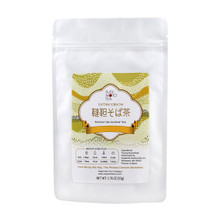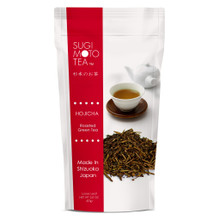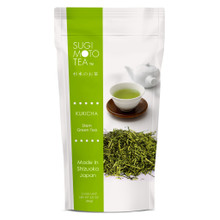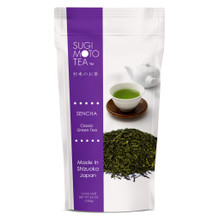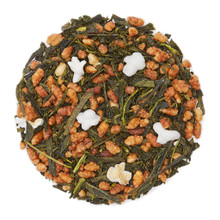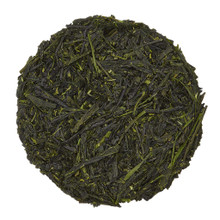The Art of Japanese Tea Production Pt. 2 – Our Role as a Tea Producer
Introduction
Many people assume that the tea they drink comes directly from a farm, with the farmer responsible for everything from cultivation to the final packaged product. While tea farmers are essential to growing and harvesting high-quality tea leaves, the reality is that in Japan, farmers and producers play distinct yet complementary roles in crafting the best teas.
At Sugimoto Tea, our role as a producer goes beyond refining tea—we are deeply committed to supporting the farmers we work with. Japan’s tea industry is facing serious challenges with the declining domestic consumption of quality tea making it increasingly difficult for sencha farmers to sustain their businesses. By selling more Japanese tea, especially sencha, in the U.S., we hope to help these farmers thrive.
Unlike in some other tea-producing regions where farmers handle both cultivation and processing, the Japanese tea industry operates under a highly specialized system. Farmers focus on growing and harvesting, while tea producers take on the crucial next steps: evaluating, sorting, blending, and finishing teas. At Sugimoto Tea, we take pride in our role as a producer, ensuring that every batch of tea meets the highest standards of consistency and excellence.
Our Relationship with Farmers
One of the most important aspects of our work as a tea producer is our direct relationships with farmers. Unlike many companies that purchase teas through government-run auctions, we work directly with farmers, establishing long-term partnerships built on trust and mutual respect.
By working closely with farmers, we ensure access to the highest-quality leaves while also providing farmers with greater financial stability. This approach allows us to support sustainable farming practices and contribute to the overall well-being of the farmers and our community. Our collaboration goes beyond transactions—we share knowledge, exchange feedback, and work together to continuously improve the quality of our teas.
In addition to purchasing high-quality aracha (the unrefined tea purchased by producers), we also produce tea products for farmers who sell them under their own brands. This partnership allows them to expand their offerings and reach more customers, ensuring their businesses remain sustainable. Our relationships with farmers is the foundation of our work, and we take great pride in supporting them in any way we can.
What Happens After Harvest?
Japanese tea production is a two-part process: farming and production. Farmers are responsible for cultivating the tea plants, selecting the right cultivars, and carefully timing the harvest for optimal flavor.
Once the leaves are picked, they go through steaming, a critical step that halts oxidation and preserves the tea’s vibrant color and fresh taste. This steaming process is precise—just a few seconds can significantly alter the final flavor. After the leaves have been steamed, farmers also handle the initial drying of the tea leaves. At this stage, the tea is known as aracha. Farmers then either sell their aracha at government-run auctions or directly to tea producers like us.
At Sugimoto Tea, we source directly from farmers. This not only strengthens our long-term relationships with farmers but also allows for better traceability, giving us and our customers confidence in where and how the tea is produced.
Evaluating
Each spring, as the first harvest arrives, we receive a diverse selection of aracha, each with its own unique characteristics shaped by variations in weather, soil, and harvest timing. Even leaves picked just a day apart can reveal subtle differences in flavor and aroma.
This is where the expertise of a chashi, or tea master, becomes essential. At Sugimoto Tea, this responsibility now belongs to our third-generation tea master, Masaaki Sugimoto, though his father, recently retired second-generation tea master Hiroyuki Sugimoto, still assists in the evaluation process. Together, they carefully evaluate each batch using finely honed sensory skills. This evaluation process is both complex and meticulous, requiring years of experience and an acute awareness of subtle tea characteristics.
Each purchase is documented in detail, including the tea’s origin, cultivar, steaming method, and processing style. This careful tracking ensures that our teas maintain their high quality year after year. The evaluation stage is not just about selection—it directly influences how we process, roast, and sort the tea in later stages.
Blending
While blending was covered in-depth in The Art of Japanese Tea Production Pt. 1 – Why Blending Matters, here we focus on how blending integrates into the finishing process. By carefully selecting and combining different lots of aracha, we ensure that our final products have a balanced and refined flavor before moving into the final drying and roasting stage.
After blending, tea undergoes sorting.
Sorting
When tea plants are harvested, they are cut at the stem, meaning that aracha contains a mix of leaves, stems, and fine particles known as fanning and tea dust. It is the producer’s responsibility to carefully sort these components, ensuring that each element is separated.
The process begins with sieving, where the tea passes through multiple levels of mesh to remove smaller leaves and fine dust particles. After this initial sorting, an air-based separation method is used to distinguish between heavier leaves and lighter pieces, such as stems. These components are then sorted into different categories based on size—large, medium, and small—which determines the appropriate hi-ire (final drying). As a final step, after hi-ire, an advanced color-sorting machine is used to detect and remove any unfavorable-colored pieces, ensuring only the best leaves make it into the final product. Finally, we make a blend of large, medium, and small pieces.
This meticulous sorting process is essential to achieving a consistent and balanced tea, allowing each batch to maintain the high standards expected from expertly crafted Japanese tea.
Hi-Ire
One of the last steps in tea making is hi-ire, a final drying of the leaves. Aracha is dried by farmers but still has excess moisture which causes quick degradation. Tea producers utilize the hi-ire process to fully reduce the moisture which results in adding a unique firing flavor profile to teas. The Sugimoto family's unique hi-ire uses high temperatures that most tea leaves can't handle. However, Hiroyuki Sugimoto discovered that tea leaves from Shizuoka’s mountainous regions could endure this heat.
By cultivating strong relationships with farmers, we are able to source high-quality leaves that can withstand our high-temperature final drying process. This relationship ensures that we can continue to produce the deeply roasted, umami-rich tea that our customers love.
Within the world of Japanese tea, conventional wisdom dictates that the appearance of the leaf and grassiness of the tea must be maintained through a moderate steaming and hi-ire. However, Sugimoto Tea Company takes a different approach, embracing the deep-steamed fukamushi style, which results in a rich flavor profile but a higher proportion of broken leaves, prioritizing taste over appearance. We also use high-temperature hi-ire, reducing grassiness while enhancing a bold, roasted aroma — creating a distinct flavor profile that our customers will love and drink every day.
“Delicious tea over beautiful tea — just like people, it’s what’s on the inside that truly counts. That’s why we defy conventional standards and commit to deep-steamed tea with a high-temperature roasting.” - Hiroyuki Sugimoto
Final Processing
Beyond selecting and finishing our teas, there are extra steps to craft some specific offerings that highlight the versatility of Japanese tea. For Hojicha, for example, we carefully roast the tea leaves to bring out their signature warm, nutty aroma while balancing sweetness and depth.
For blends like Genmaicha, we ensure that the ratio of tea to toasted rice is expertly balanced to achieve the perfect harmony of flavors. Similarly, our Yuzu Matcha Kukicha is made by blending yuzu peel and powder to create a vibrant citrus aroma that complements the tea’s natural character.
Grinding is another critical step—whether it’s for matcha or hojicha powder, we use specialized grinding machines to achieve the perfect fine consistency for smooth preparation.
Packing
One of the most grueling and time-consuming tasks in tea production is the packing of finished tea—a job that requires patience, precision, and endurance. This is especially true for matcha, which, due to its fine, powdery nature, is both messy and delicate to handle. Each bag must be carefully filled by hand with the help of a machine, ensuring accuracy while minimizing waste. Unlike loose-leaf teas, where packaging can be done in larger quantities at once, matcha demands individual attention, making the process far more labor-intensive.
During packing, the tea is exposed to air, and since oxidation can affect freshness, speed is critical. Our team members work diligently and efficiently, moving with precision to seal in the tea’s quality as quickly as possible. This means long hours of repetitive, detail-oriented work, with little time to pause and rest. It is an exhausting yet essential step in maintaining the integrity of our teas.
We deeply respect and appreciate the dedication of each member of our factory team. Their hard work is often unseen by customers, yet without their skill and commitment, the matcha and loose-leaf teas we produce would never reach their full potential. Every package of tea is a testament to their craftsmanship, patience, and unwavering effort, ensuring that what reaches the customer is nothing short of the highest quality.
Safety and Quality Assurance
One of the most overlooked yet critical steps in tea production is safety and quality assurance. While tea has been cultivated and processed for centuries, the industry has not always prioritized rigorous safety standards. In the past, many aspects of production were done with little oversight—simply because such measures were not common practice. Over the past 30 years, however, we have made it our mission to go above and beyond in ensuring that every step of our process meets the highest safety and quality standards.
Maintaining a clean and controlled environment is another essential part of our commitment. Our facility is equipped with an air shower system that removes any dust or contaminants before entering production areas. Even something as simple as handwashing is monitored—if hands are not properly washed and scrubbed with a brush, the doors to the factory will not open, ensuring that every worker upholds the highest hygiene standards.
Additionally, strict air pressure controls ensure that outside air cannot enter when doors are opened, further protecting the tea from unwanted exposure. Beyond maintaining a clean facility, we conduct extensive testing to verify the safety and consistency of our teas. This includes:
- Microbial testing to ensure no unwanted bacteria are present
- Moisture analysis to maintain optimal freshness
- Radiation screening for an extra layer of safety
- Heavy metal testing to confirm purity and compliance with strict regulations
Every step we take is guided by a simple principle: we care deeply about our customers and the quality of the tea they drink. While some may see these extra measures as unnecessary, we see them as essential to maintaining trust and delivering the highest-quality tea possible.
Conclusion
Crafting exceptional tea is a collaborative effort that involves expertise in every stage of production—from evaluating and blending to refining, roasting, and packaging. Farmers provide the foundation, while producers carefully refine and balance each element to create a consistent and enjoyable tea experience.
Our dedication to working closely with farmers and overseeing every step of production ensures that each cup of tea reflects generations of craftsmanship. Every detail—from cultivation to finishing—is carefully considered to bring out the best flavor, aroma, and character in every sip.
By understanding the full journey of Japanese tea, we hope you’ll develop a deeper understanding for the craftsmanship, dedication, and intricate work that go into each step of the process.















